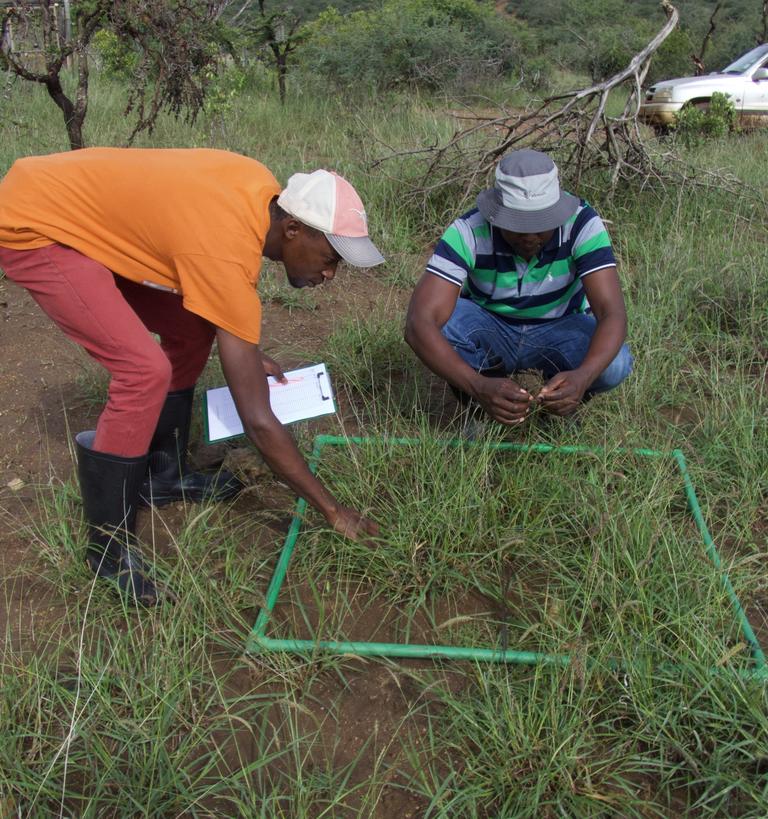Buffelgrass Release Experiment

Buffelgrass Release Experiment
Institutions:
Nature Kenya (Kenya)
University of Texas at Austin (USA)
Lee and Ramona Bass Foundation (USA)
Principal Investigators:
Dino Martins, dino.martins@stonybrook.edu
Aaron Rhodes, aaronrhodes@utexas.edu
Rob Plowes, robplowes@utexas.edu
Project Manager:
Rob Plowes
The Buffelgrass Release Experiment at Mpala Research Station, a collaboration between Nature Kenya and the University of Texas at Austin, examines how the invasiveness of buffelgrass (Cenchrus ciliaris) responds to the removal of natural ecological stressors in its native Kenyan savanna. Insighs from this research is informing invasion ecology, revealing patterns of invasiveness of buffelgrass outside of its native range. Our research has utilized long-term exclosure plots established across six sites that span a rainfall gradient, with each site including both fenced and unfenced plots. Initially, these plots were used to systematically exclude or reduce the effects of grazing by large wildlife, insect herbivory, fungal pathogens, and competition from other plants. Specific treatments involve fencing to exclude ungulates, application of insecticides and fungicides, and regular clipping to reduce plant competition. The purpose was to test the Enemy Release Hypothesis, which posits that buffelgrass becomes more invasive when its natural enemies and competitors are absent, and to understand better the ecological controls on its growth and invasion potential within its native range.
The experimental program collects multi-year data on buffelgrass growth, reproduction, response to natural enemies like stem-boring insects and smut fungi, and its competitive relationships with native savanna plants. The findings suggest that when released from a diverse set of natural stressors, especially under favorable rainfall conditions, buffelgrass displays more pronounced invasive traits such as rapid spread and increased productivity. Biotic resistance from native herbivores and plant competitors normally limits buffelgrass dominance in these African savannas, but reducing these pressures can enhance its invasiveness. Interestingly, our research shows that when certain stressors, like ungulates, were excluded, some guilds of insects (such as stem-galling species) became more prevalent, sometimes compensating for the loss of ungulates.
Given the outsized role that the dynamic and abundant ungulate community plays in the invasiveness of grasses and the invasibility of savannas, we have initiated a rewilding experiment that involves removing fencing in phases to approximate the impact of shifting ungulate communities. Preliminary results indicate that removing ungulates increases the incidence ofarthropod and pathogen damage on the leaves of buffelgrass. This suggests that ungulates reduce disease and pests; therefore, maintaining native ungulates is beneficial to the health of savannas and rangelands, and potentially nearby agricultural lands. As humans continue to alter the ungulate communities and their behavior through development and direct management, it is important to consider the potential deleterious impacts of reductions in ungulate abundance and biodiversity on range and agricultural health.
Key Findings and Publications:
These results demonstrate the complex interplay of ecological factors regulating buffelgrass in its native habitat and underscore how losing these controls can cause a shift toward invasive dominance, similar to patterns seen where buffelgrass has become an aggressive invader outside Africa. The outcomes from this experiment inform both sustainable pasture management in Africa and strategies for biocontrol and management in places where buffelgrass is a problematic introduced species.
Our decade-long research partnership at Mpala Research Centre has been critical to informing the nature of invasive grasses, increasing taxonomic understanding of novel animal species, and has helped produce three Kenyan ecology professionals, supported five Kenyan technicians, and collaborated with dozens of local students. We are committed to collaborating with Kenyan experts and fostering the development of future generations.
Rhodes, A. C., R. M. Plowes, E. A. Bowman, A. Gaitho, I. Ng'Iru, D. J. Martins, and L. E. Gilbert. 2024. Systematic reduction of natural enemies and competition across variable precipitation approximates buffelgrass invasiveness (Cenchrus ciliaris) in its native range. Ecology and Evolution 14:e11350.
